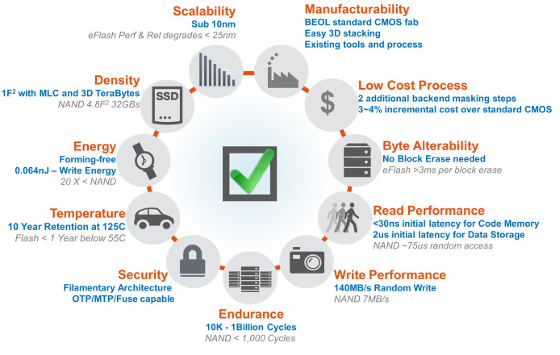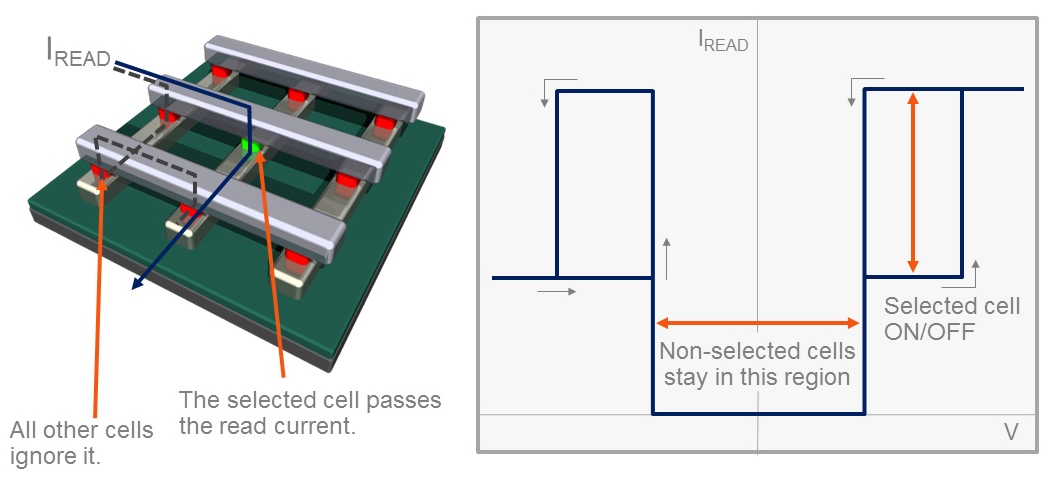Crossbar RRAM to Provide Next Years Terabyte-on-a-Chip
Using 1TnR implementation
This is a Press Release edited by StorageNewsletter.com on July 7, 2014 at 2:40 pmCrossbar, Inc., a start-up company pioneering 3D Resistive RAM (RRAM) technology, disclosed further details behind its non-volatile RRAM technology.
RRAM Technology Ouperforms Flash Memory Specs
The company announced it has demonstrated pre-production 1MB arrays using its patented 1TnR (1 Transistor driving n Resistive memory cells) selectivity for R/W operations, representing a milestone toward commercializing terabyte scale memory arrays on a postage stamp size chip.
1TnR makes it possible for a single transistor to manage a large number of interconnected memory cells, enabling high capacity solid-state storage. Other memories utilizing passive cross-point architectures, such as Resistive RAM, PCM (Phase Change Memory) and neuromorphic systems, experience unintended electrical current when accessing high density storage due to a phenomenon called ‘sneak path current’.
Until now, these memories have not been able to access data and have consumed excessive power, making dense memory configurations impractical. For the past decade, many of the world’s experts have attempted to solve this issue, but with limited success.
Crossbar delivers a solution to this problem by enabling a single transistor to drive over 2,000 memory cells with very low power, producing dense Crossbar RRAM semiconductor memories.
“Crossbar has once again broken through traditional boundaries with its innovative and patented 3D RRAM technology,” said George Minassian, CEO, Crossbar. “With 1TnR, companies will realize the dream of extremely dense, highly reliable, and high performance solid state storage. It’s truly ground breaking and has the potential to redefine what’s possible in enterprise storage and high-capacity non-volatile SoC memories.“
According to IBM, 2.5EB – or 2.5 billion GB – of data was generated every day in 2012. All of this data needs to be stored and accessed quickly, at low power, and in a compact space. Enterprises and service providers struggle with managing storage systems using aging disk drive technologies. Storage systems must be re-architected using solid-state storage technologies. Hybrid, or all flash, storage solutions are gaining momentum, but the majority of the enterprise storage market still relies on disk drive technologies as a core part of their architectures, for cost, available capacities and reliability concerns.
The transformation to next generation high capacity storage systems will require a new approach to solid-state storage devices and their interconnected processors. This transformation will enable hundreds of terabytes, in a small form factor, to be accessed at high speed, high throughput and high IO/s, while consuming less power at lower cost.
Many of these technical challenges overcome by RRAM technology, including:
- Cell physics – Traditional flash memory materials wear out quickly after being accessed and rewritten too many times, leading to degrading performance, unrecoverable data loss and limited lifetime. RRAM solutions do not suffer similar wear-out issues due to the technology’s fundamental memory cell structure, based on metallic nano-filament in a non-conductive layer;
- Economics – Semiconductor manufacturing facilities for advanced NAND flash require multi-billion dollar investments. RRAM can be stacked in 3D directly on top of standard CMOS wafers, making it cost effective to manufacture;
- Dense memory array architecture – The 1TnR selectivity feature, invented and patented by Crossbar, solves the problem of scalable high-capacity storage.
Latest 1TnR RRAM technology is built upon the foundation of its one transistor per memory cell technology that has been validated in silicon using the company’s 1MB storage device for embedded code applications. This device features low latency and fast read performance, as required for code applications. Its simplicity, capabilities and CMOS compatibility enable logic and memory to be cost-effectively integrated onto a single chip, at the latest technology node, on standard manufacturing processes. Together, the company’s 1TnR technology, for high-capacity 3D RRAM storage applications, and 1T1R technology for embedded code applications, forms the basis for the company’s IP licensing and standalone product line roadmap.
Crossbar is currently finalizing agreements with several semiconductor companies and plans to announce its first licensing agreements with customers shortly. The company intends to present further technical details of its 1TnR technology at upcoming conferences.
“Scaling to a terabyte on a chip requires a brand new approach to creating a super dense memory array, which has been a stumbling block for large scale non-volatile memory,” said Alan Niebel, founder and CEO, Webfeet Research, Inc. “With Crossbar’s 1TnR innovation, we may see a future where non-volatile memory can realistically achieve cost effective and high yields without 32 or more monolithically connected layers, possibly replacing disk drives for all but archival storage.”
“Crossbar’s RRAM approach covers both spectrums of the market with its 1TnR technology,” said James Bagley, senior analyst of SSG-NOW. “While its proven 1T1R technology targets the embedded code applications, its ability to demonstrate 1TnR directly impacts the high-capacity 3D RRAM storage applications. Crossbar is well on its way to redefining what is technologically possible in the enterprise storage market.“
“The memory technology that replaces NAND flash must have a compelling cost structure, and this means that everything will have to shrink beyond NAND’s limits: not only the bit cell, but also the select mechanism,” said Jim Handy, principal analyst, Objective Analysis. “Crossbar’s 1TnR technology is a good candidate in this regard, with its ability to share a single select transistor among a number of memory bits.”
“The potential for non-volatile memory in the enterprise is huge, and companies continue to innovate in order to overcome the shortcomings of current technologies,” said Randy Kerns, senior strategist and analyst, the Evaluator Group. “Crossbar’s RRAM is a new approach to address the issues. This technology allows enterprise storage to have hundreds of terabytes in a single system, built completely on non-volatile memory.“
“Crossbar’s continued progress is another validation that its RRAM solution will be the winning next generation memory technology,” said Sherry Garber, founding partner, Convergent Semiconductors. “The technical achievement outlined in 1TnR is truly remarkable and provides the most viable path to achieving extremely high density, highly reliable, and high performance solid state storage.”
“The advancement and growth of non-volatile memory depends upon the continued development of new technologies,” said Tom Coughlin, president, Coughlin Associates. “Crossbar has contributed to the advance of resistive memory technology with its development of 1TnR in working silicon samples.”
“Crossbar RRAM technology seems very promising in terms of scalability, endurance, power consumption and especially manufacturing cost,” said Yann de Charentenay, senior analyst, MEMS devices and technologies at Yole Développement.
In Yole’s report, entitled Emerging Non-Volatile Memory (released in Feb. 2013), the company was expecting that RRAM technology would be the best candidate for NAND replacement in mass storage applications.
“Since this technology and market analysis has been published, RRAM technology has made significant progress in term of scalability/chip density. We are excited to see the first Crossbar RRAM samples,” he added.













 Subscribe to our free daily newsletter
Subscribe to our free daily newsletter
